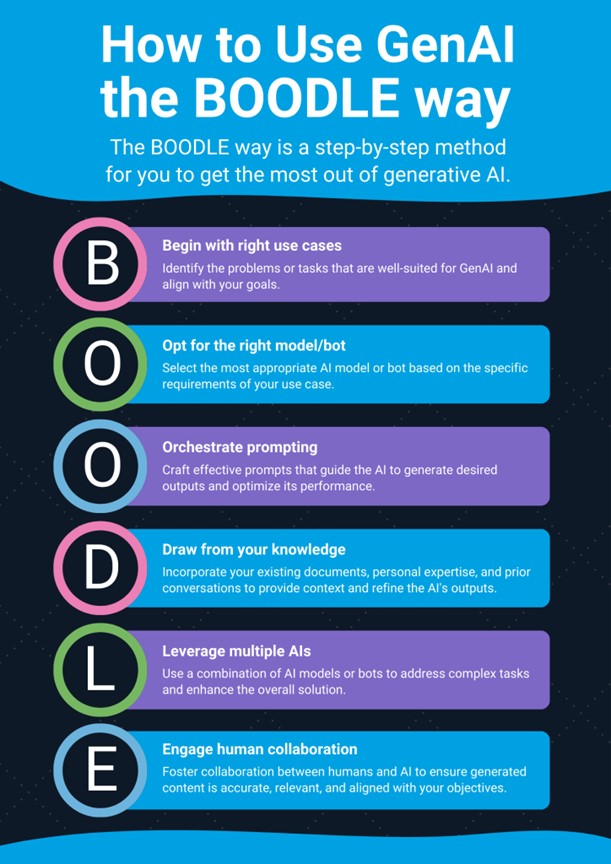The Boodle Way
In today’s rapidly evolving world of Generative AI (GenAI), it’s crucial to have a structured approach to harness its full potential.

The BOODLE Way is a proven methodology that combines the right people, AI, and knowledge to achieve exceptional results. This post will guide you through the BOODLE Way, helping you understand why it matters and how to implement it effectively.
The BOODLE Way is a step-by-step approach designed to maximize the value of GenAI. It encompasses six key elements:
B – Begin with the right use cases
- Identify problems or tasks that are well-suited for GenAI and align with your goals.
- Consider factors such as complexity, data availability, and potential impact.
Example: A content marketing team identifies blog post ideation and drafting as a suitable use case for GenAI, considering the complexity of the task, the availability of existing blog post data, and the potential impact on their content creation process.
O- Opt for the right model/bot
- Select the most appropriate AI model or bot based on the specific requirements of your use case.
- Evaluate factors such as performance, specialization, and ease of use.
Example: For the blog post creation use case, the team evaluates different AI writing assistants based on their performance in generating relevant ideas, their specialization in the team’s niche, and the ease of integrating them into their workflow. They select the most suitable option.
O- Orchestrate prompting
- Craft effective prompts that guide the AI to generate desired outputs and optimize its performance.
- Experiment with different prompting techniques and iterate based on the results.
Example: The team experiments with different prompting techniques for blog post ideation, such as providing a topic and target audience, or giving a title and outline. They iterate based on the quality and relevance of the generated ideas.
D- Draw from your knowledge
- Incorporate your existing documents, personal expertise, and prior conversations to provide context and refine the AI’s outputs.
- Leverage the BoodleBox platform to easily attach relevant knowledge to your chats.
Example: To improve the relevance and accuracy of the AI-generated blog post drafts, the team attaches their existing blog posts, style guide, and target audience personas to the chat. They use this knowledge to refine the AI’s outputs.
L- Leverage multiple AIs
- Use a combination of AI models or bots to address complex tasks and enhance the overall solution.
- Explore the diverse range of AI tools available on the BoodleBox platform.
Example: The content team uses one AI tool for blog post ideation, another for drafting, and a third for proofreading and optimization. They leverage the strengths of each tool to create a comprehensive solution.
E- Engage human collaboration
- Foster collaboration between humans and AI to ensure generated content is accurate, relevant, and aligned with your objectives.
- Encourage team members to provide feedback, refine outputs, and share insights.
Example: Using GroupChats, the team members review the AI-generated blog post drafts, provide feedback, and make necessary edits to ensure the content aligns with their brand voice, target audience, and quality standards. They collaborate with the AI to iteratively improve the output.
